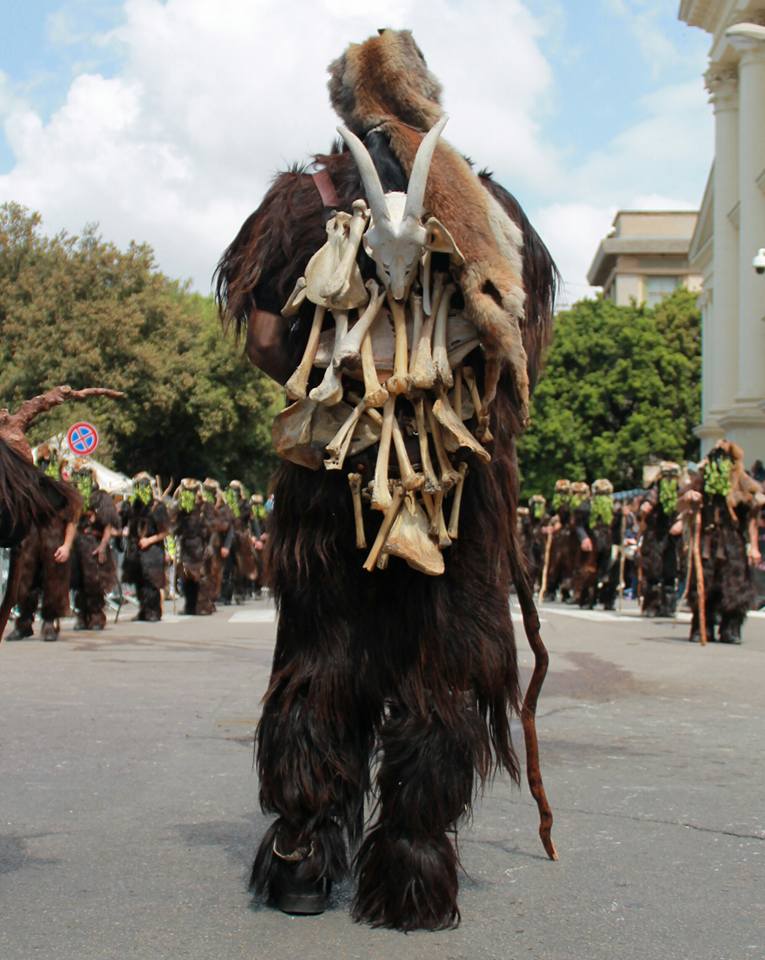Sardinia’s traditional carnival, and especially central Sardinia’s, has ancestral origins that refer to pagan and tragic rites. Sos Colonganos are the masks of Austis’ carnival and their name derives from the Greek word “kolos”, which means sheep, so that their denomination should mean “those who dressed as sheep”. But “kòlos” also means “the one who is beaten, tortured” and that is the victim of the carnival, commonly called s’Urtzu.
Description of the masks
Although similar to the Mamuthones, perhaps Barbagia’s most famous mask, Sos Colonganos differ from all the others for some details, including the use of animal bones and the strawberry tree fruits. More in detail, Sos Colonganos wear garments made of sheepskin while on their heads they wear fox or marten skins. The skins are necessary because, in the context of paganism, they invoke the rain. On their shoulders, instead of cowbells, they carry animal bones that recall death and resurrection (de s’Urtzu). The men, equipped with sticks and pitchforks, have their faces covered by a cork mask adorned with strawberry tree branches. Even the choice of the plant is not accidental, as the strawberry tree is an evergreen plant used in a variety of ways that grows in the cold season and whose production is very abundant throughout Sardinia. As in other Sardinian carnivals, the sacrificial victim is s’Urtzu, which strongly references the figure of the Latin Orcus, or the god of the underworld. In Austis, s’Urtzu is dressed in wild boar skins and is kept at bay and beaten by the other figures while emitting cries of terror. Sos Bardianos, on the other hand, represent the guardians who wear the classic ‘gabbanu’, a black orbaceous coat with a hood. They always carry two instruments with them: sticks, used to beat s’Urtzu, and an animal horn, used as a musical instrument to announce the passage of the procession.
Austis’ carnival mask was brought to light during the studies conducted by Bonaventura Licheri, who, in 1700, described them with the following poem:
E in su fogulone ballant sos Colonganos, cun urteddos in manos de bardaneris. Bricant che gherrieris cun fustes e furcones, cun peddes de matzones, craba e isbirru. Meres in dogni chirru che una suferentzia, che una penetentzia, dilliriados. De ossos carrigados in palas a muntone, e frunzas de lidone ant pro caratza. Sa pecadora ratza paret bestid’a dolu, de dimonios su ‘olu in terr’avallu.
Translation: Sos Colonganos dance around the big bonfire, with brigand knives in their hands. They jump as if they were in a fight, equipped with sticks and pitchforks. They are covered with fox, goat and marten skins. Everywhere you see “printzipales” seized by a frenzy, delirious, like those suffering in penance. Their shoulders are loaded with bones and on their faces is a mask of strawberry tree fronds. This race of sinners seems to be dressed in mourning and is similar to a flight of demons that has found shelter on earth.
Must-see in Austis
When to see the traditional Austis masks
The first official release of Sos Colonganos is on January 16th, on the occasion of the feast of Sant’Antonio Abate, when a fire is lit in honor of the saint. In particular, it is said that Sant Antonio Abate stole a spark from the underworld and gave it to humans on Earth. The dance around the fire also refers to the pagan ritual according to which Sos Colonganos stage a dance to attract the attention of the God of Vegetation so that the lands will be fertile and the agricultural crops profitable. In general, January 16th is the date of the beginning of the Carnivals in Sardinia. Despite its ancient origins, the Austis carnival was only brought to light a few years ago. Every year during the days of the carnival, Sos Colonganos gather in front of the bonfire lit for the occasion and, like penitents, beat their sticks on the ground and jump on the spot making an archaic and gloomy sound. This is followed by a community dinner where participants are gathered around the fire and are immersed in a festive atmosphere, between Sardinian dances and inviting scents.










